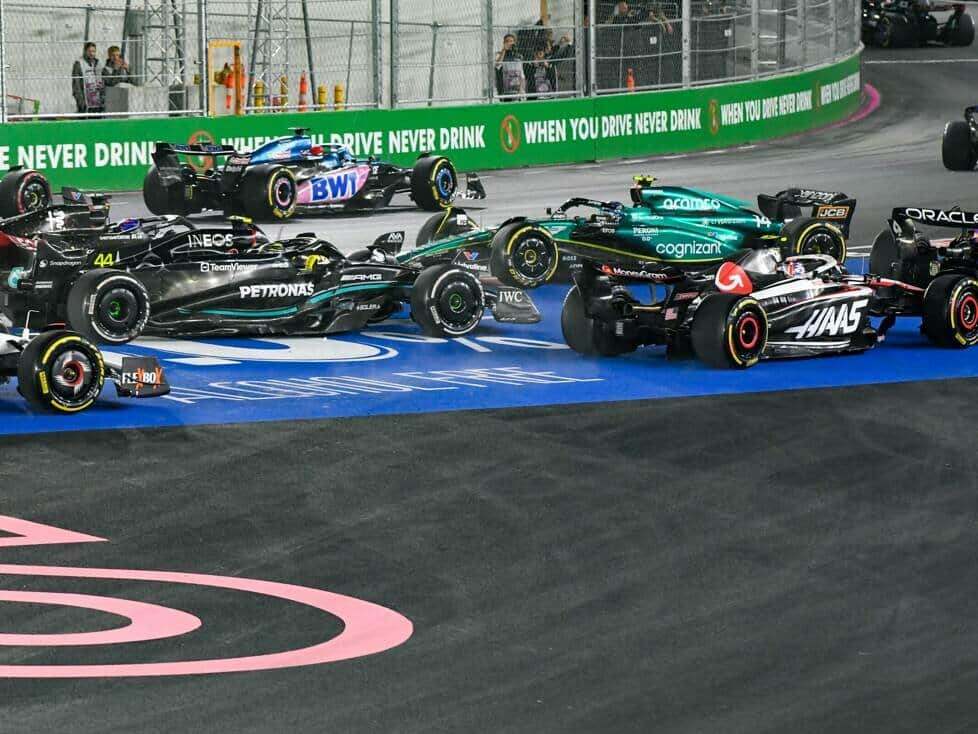Pirelli motorsport boss Mario Isola explains that Pirelli’s options were limited with Las Vegas asphalt – then the drivers would just have to adapt
Complaints from the drivers about the slippery asphalt characterized the first Las Vegas Grand Prix of Formula 1. Spoiled by the “gold standard”, as George Russell called the asphalt in Jeddah, several Formula 1 drivers wondered why there was such a step backwards in Vegas
Pirelli Motorsport boss Mario Isola had already explained during the weekend that a special treatment of the asphalt like in Jeddah was not possible. Las Vegas is a real street circuit that is also open to traffic.
It is well known that when asphalt is freshly laid, it has to “sweat”, i.e. secrete bitumen, for a year before it reaches its final grip level. The asphalt in Vegas is at this stage, which is why it was so slippery. In Jeddah, the bitumen was pressed out of the asphalt with high-pressure cleaners – an artificial ageing process.
If the asphalt offers too little grip, why doesn’t tire supplier Pirelli react? “I’m not sure if we can do anything with the tires, unless we drive even softer than we do now,” says Isola after the premiere on the “strip”. Pirelli offers five compounds from C1 (hardest) to C5 (softest), three of which are brought to the races
Drivers are in demand
“That’s the discussion we had in Monaco. The three selected tire compounds that we also use here [C3 to C5] are probably too hard for Monaco. And in cold temperatures or drying conditions or mixed conditions, the grip is obviously very low. And when there’s a safety car, these situations get even worse.”
According to Isola, the tires lose 35 to 40 degrees under normal conditions on the home straight alone. “I can imagine that they lose even more behind the safety car.” But then it’s up to the drivers.
In general, he demands a little more flexibility from them: “I understand that it’s nice for the drivers to have grip, then they can push. Of course, I respect every opinion of the drivers – they drive the car and know what they are doing. But I think we should have different levels of grip in 24 different races and it’s good to have those differences. “
“Personally, I think we should have different types of tarmac at the different circuits because if we have the same level of grip everywhere, it’s not in the DNA of Formula 1. We don’t have the same grip in Monaco as we do in Bahrain. We choose different tires, the drivers have to adapt their driving style and pace to the grip level. “
Warm-up versus degradation: reversed signs
Pirelli poses the fundamental question: Do the Formula 1 teams want a tire that warms up quickly but has a high degradation rate, or the opposite? In addition, Charles Leclerc, who noted that it was very difficult to get the tires back up to temperature after the second safety car phase, was on the hard compound (C3).
“I would say that the hard compound was a conservative decision here. And obviously you had to push harder to get heat into the tires,” commented Isola.
“What was interesting for me was a comment from Max [Verstappen]: ‘We were able to push the tires.’ So the point is that in the future we can probably work in such a way that we sacrifice the warm-up phase a little, but protect the tires better from overheating, which the drivers don’t like either. “
“We have to make a compromise. Normally we don’t hear negative comments about the warm-up phase, but then the riders complain about overheating. Today the opposite was the case on the Hard.”
“The problem is that on a track that is not so rough, it is difficult to keep the heat in the tires if you don’t put a lot of energy into the tires and the temperatures are cold. But you can’t ask [safety car driver Bernd] Mayländer to go faster.”
“Warming up was a bit difficult because of the asphalt and the track layout, but then you could and had to push the tires to maintain the temperature. We have to take that into account [in further development]. “

